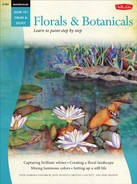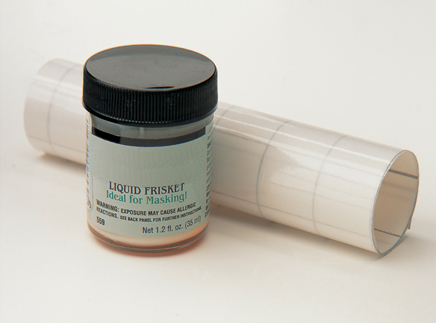Purchasing Tools and Materials
WITH THE AMAZING SELECTION of paints, brushes, papers, and other materials available, every visit to the art supply store is an adventure full of excitement and possibilities. Instead of picking out one of everything, refer to the suggested supply list in the box at right. You can purchase a limited number of supplies, but always invest in the best you can afford. You always can buy additional materials as you develop your skills and personal painting style. If you’d like to learn more about watercolor tools and materials, refer to Watercolor & Acrylic Painting Materials by William F. Powell in Walter Foster’s Artist’s library series.
Buying Paints
Watercolor paints are available in tubes, pans, and cakes. Most artists choose tube water colors because they are already moist, which makes them easy to use, and they allow you to squeeze out a large amount of color quickly and easily. Pan and cake paints, however, are small and light, which makes them convenient for travel. Whichever type you choose, be sure to select artist-grade paints. Student-grade paints are mixed with more fillers and additives, which decrease the intensity of the colors—and your painting. Artist-grade paints are made with purer pigments, so the colors are truer and richer.

PAN PAINTS Pan or cake paints are typically stored in a watercolor box, which doubles as a mixing palette. To use, moisten the block with a wet brush and scrub the pigment loose.
Choosing Colors
A beginner’s color palette doesn’t have to be extensive. In theory, all an artist really needs are the three primaries: red, yellow, and blue. But in practice, it’s more convenient and practical to select a small array of colors. Even with a minimal set, or limited palette, like the one shown, you’ll be able to mix just about any color you may need.

CHOOSING PAINTS Lightfast paint retains its color after being exposed to light over time. Colors rated I (excellent) or II (very good) will last the longest. Pigments with low ratings are sometimes referred to as fugitive colors because they fade over time. If you don’t see the rating on the tube, ask your art supply store for an information sheet from the manufacturer.
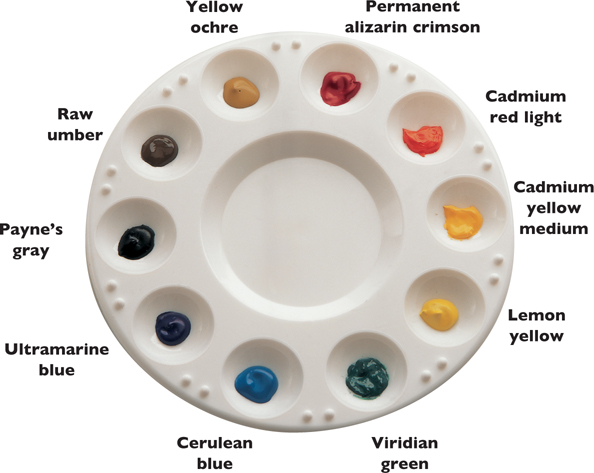
STARTING OUT Each artist develops his or her own favorite palette of colors—and you will too. The basic palette will get you started.
Looking at Brushes
Watercolor brushes are categorized by size, shape, and hair type. Brush size is indicated either in inches or by a number, but the numbering system varies among the different brands. For example, although a #2 brush is usually very small, the length and width of the bristles may differ slightly from manufacturer to manufacturer. In this book, brushes are referred to as small, medium, or large, so choose the sizes that fit your subjects. Brush shapes determine the type of strokes you create—rounds will yield a narrower line than flats will. Hair types are either natural or synthetic; both will do the job, but natural hairs generally cost more. For beginners, the five brushes shown make a good starter set.





DISTINGUISHING BETWEEN BRUSHES There are many styles of brushes, each with its own function. For instance, a flexible flat brush is invaluable for painting thick, even bands of color; the firm point of a small round brush is ideal for detail work; and a liner or rigger brush is great for painting very fine lines.
MASKING WITH FRISKET Liquid frisket, or masking fluid, is a latex-based substance that is either white or slightly colored. (Colored mask is easier to see on white paper.) Paper frisket is a clear adhesive that you cut with scissors or a utility knife and adhere to the painting surface. When applied, frisket will protect the paper from absorbing pigment, saving the white areas you cover.
Simplifying Supports
You can paint on many different surfaces, or supports, such as illustration board or Bristol board, but most watercolorists prefer paper. Water color paper varies by weight and texture: Hot-press paper is smooth, whereas cold-press paper has some texture. Paper also is categorized by weight, designated in pounds; the higher the number, the heavier the paper. Medium-weight 140-lb paper is popular and suitable for beginners, but a heavier paper, such as 260-lb or 300-lb, won’t buckle under multiple layers of wet paint.
Picking a Palette
Mixing palettes are available in glass, ceramic, plastic, and metal. All are easy to clean, but glass and ceramic palettes are heavier and usually more expensive. Palettes also come in many shapes, but they all contain individual color wells and at least one area for mixing.

SELECTING A STYLE Whether you choose a round-, oval-, rectangular-, or square-shaped palette, choose one with plenty of wells to hold all your paint colors. And look for a palette with a flat area that’s spacious enough to accommodate large puddles for washes.
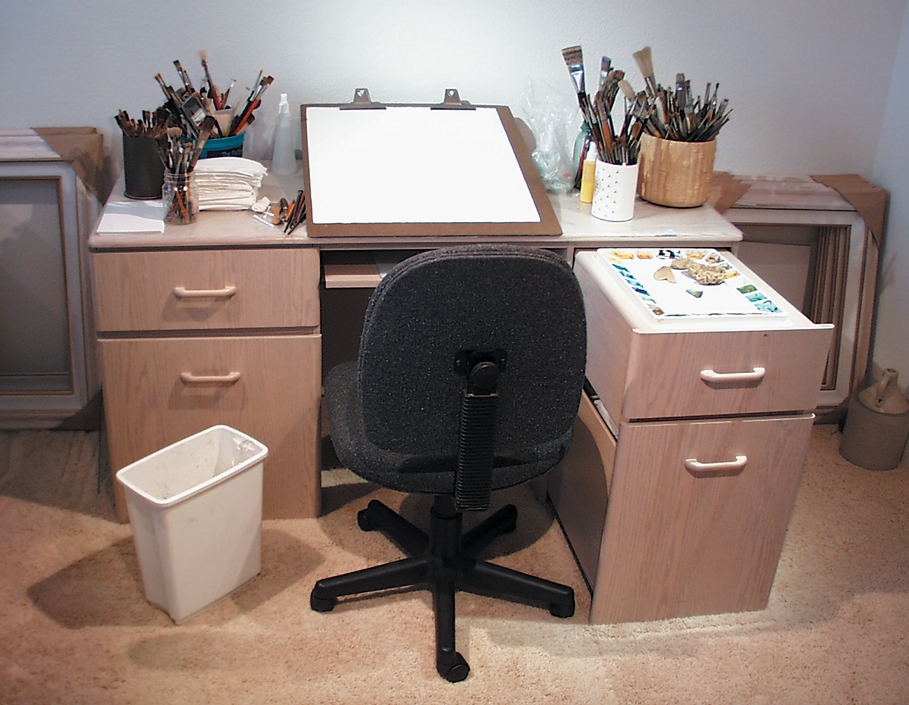
CREATING A WORK SPACE To set up an effective work station, keep three things in mind: convenience, lighting, and comfort. Try to place all your materials within easy reach, and make sure you have adequate lighting. Natural light is best, but you’ll also need artificial light for working at night or on overcast days. Finally, be sure to include a comfortable chair; it will make your painting sessions more pleasant.
Getting to know your “Extras”
You’ll also want to assemble a few extra supplies. A sketchpad, pencil, and eraser are great for making quick sketches of your subject on location and blocking in compositions. It’s also helpful to have an easel or drawing board with a smooth surface that can be tilted or adjusted. A toothbrush, salt, plastic wrap, sponges, and tissues are also good for creating a variety of special effects. Artist’s tape or masking fluid (frisket) is useful for saving the white of the paper, whereas a craft knife can be used to retrieve whites or light values. Keep a spray bottle or mister around to moisten your paints or your paper, and use a hair dryer to speed up the drying time. For convenient clean- up, keep rags or paper towels on hand, along with an extra container of water for rinsing your brushes.
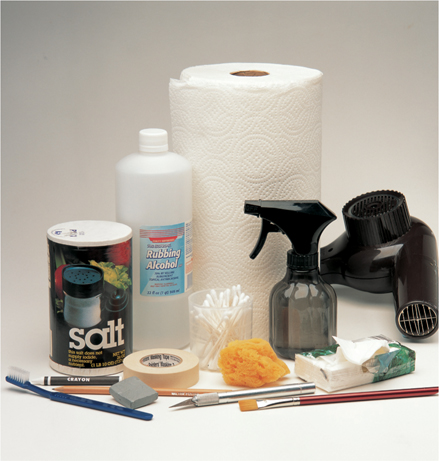
SUPPLEMENTING THE ESSENTIALS You don’t have to spend a lot of money on fancy tools. Many extras you probably already have in your kitchen or bathroom cabinet. Others are readily available at the drugstore or supermarket.
